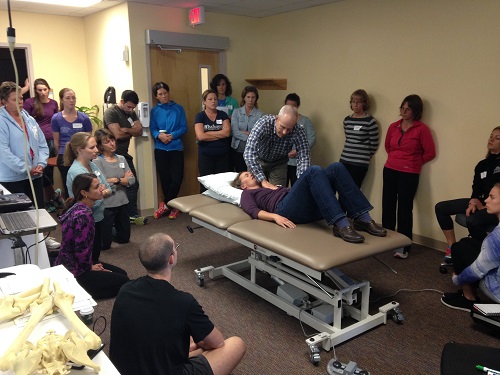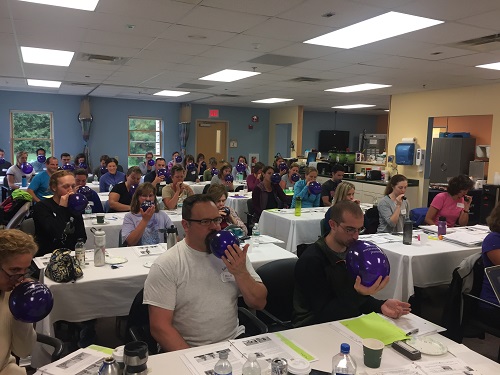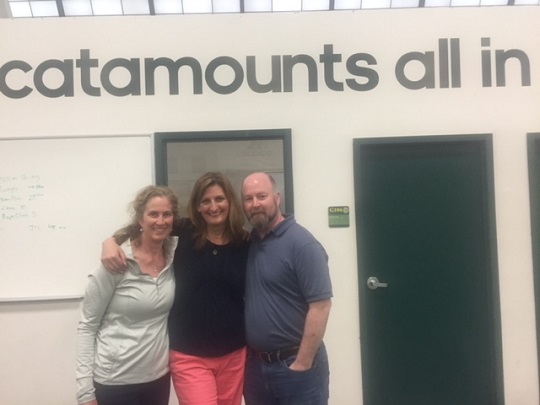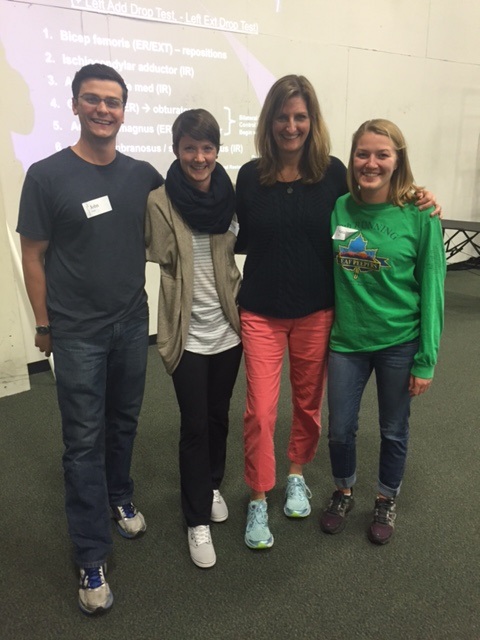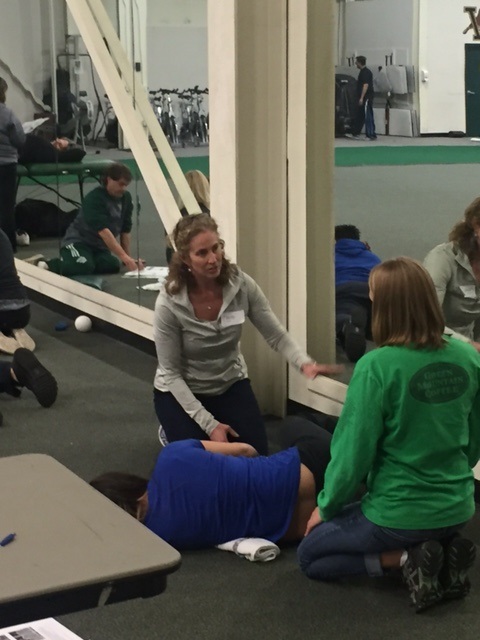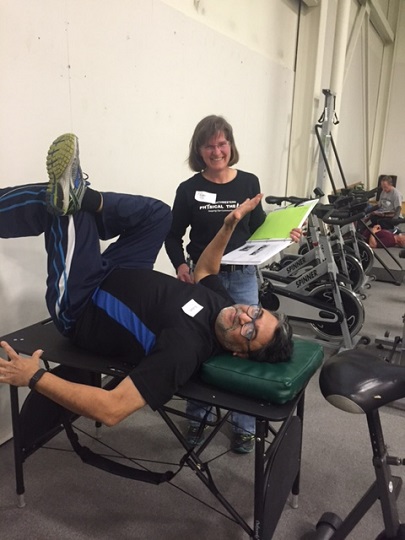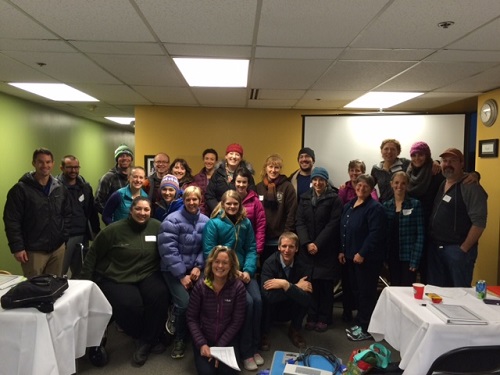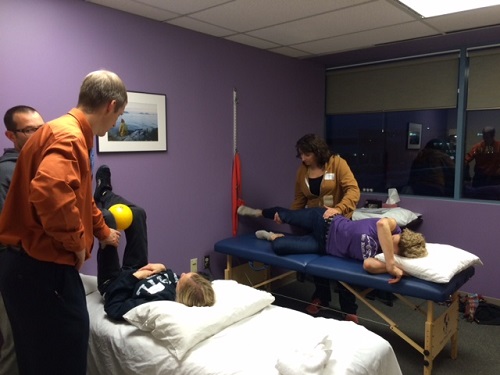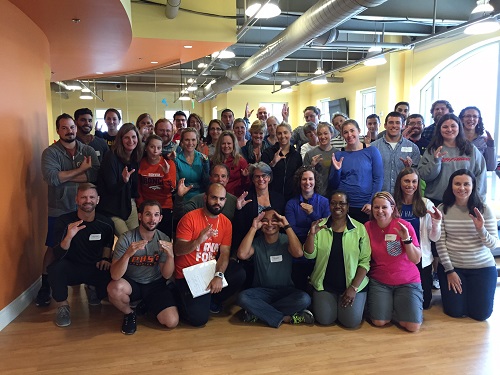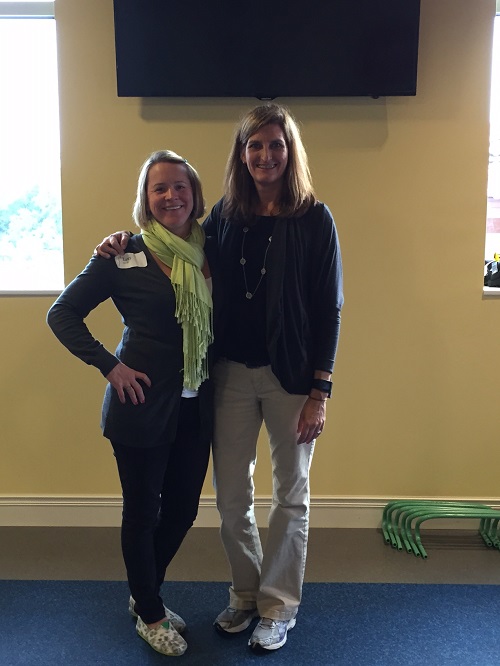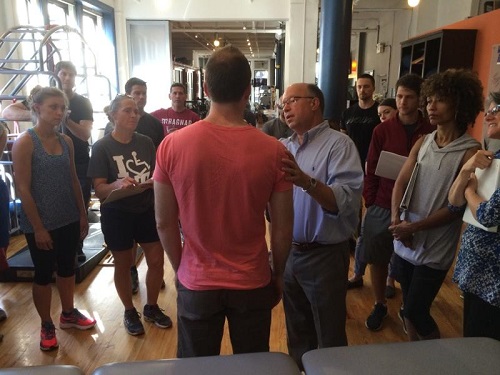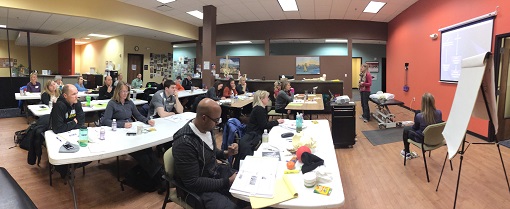Author’s Note: This is the second installment in an ongoing series on my blog, Integrative Human Performance, meant to introduce the Postural Restoration Institute and the concepts that it teaches, as well as how we integrate them into training and rehab. You can view this post in its original format on the blog by clicking here. If you missed the first installment, you can click here to give that a read in its original format, or click here to read it on the PRI website. In this installment, I’ll take the neurological underpinnings of PRI’s methodology (discussed in Part 1) a bit farther to discuss the biochemical and physiological responses to the different autonomic states. I’ll give a brief insight into the relevance of these responses to muscle activity at the end, and will focus in detail on how that impacts postural and movement patterns in the next couple of installments.
In the last installment, I explained that while on the surface PRI may seem solely concerned with postural and movement dysfunctions, its ultimate goal is to assess a person’s autonomic state and their relative balance of sympathetic and parasympathetic output, as well as the ability to change which division is more dominant in the face of various stimuli. In this post, I will outline the specific physiological responses that these autonomic subdivisions elicit and detail the mechanisms by which they work. It is my hope that this explanation will give you a better understanding of how the neurological influences outlined in part one translate to patterns of movement and muscle activity that I will describe in parts three and beyond.
Autonomic Nervous System Function: Mechanisms Responsible for its Effects
As I briefly mentioned in part one, higher brain centers in the limbic system and even the cerebral cortex send information to peripheral effectors via action potentials through efferent neuronal circuits. These circuits pass through the brainstem, which contains the reticular formation in the pons and medulla. While in the first post I described how these nerve impulses can impact muscle tone and activity, I only briefly mentioned that they also impact traditional “autonomic functions” such as heart rate and the rate and depth of ventilation. In fact, the input the brainstem has in cardiorespiratory function is, at least in the sense of direct influence, more profound than its influence on skeletal muscle. This is made apparent by the fact that the Cardiovascular Control Center (CCC) and the Respiratory Control Center (RCC), which are responsible for regulation of heart and breathing activity, respectively, are both located in the brainstem.
The Cardiovascular Control Center is in the medulla oblongata (cue the obligatory The Waterboyreference). The CCC innervates the heart with parasympathetic fibers via the vagus nerve (which I mentioned briefly in part one) as well as via sympathetic cardiac accelerator nerves. While cardiomyocytes can spontaneously depolarize and initiate a heartbeat, these autonomic nerves enable the CCC to alter heart function in response to afferent feedback from peripheral chemoreceptors and mechanoreceptors as well as efferent feedforward stimulation via higher brain centers. At rest, the parasympathetic system predominates and allows for relatively minor changes in heart activity by increasing or decreasing its output. In other words, the sympathetic system does not appreciably contribute to adjustments to cardiac activity at rest. The same is actually true of the onset of exercise–the increase in heart rate and contraction force are largely due to the withdrawal of parasympathetic output up to approximately 100 beats per minute, at which point the sympathetic nervous system will increase activity to meet any further increase in demand.
The Respiratory Control Center is also located in the medulla oblongata as well as in the pons. The most widely-accepted theory behind its function is the Group Pacemaker Hypothesis, which states that there are four distinct regions that are responsible for initiating and regulating the breathing process, two in each of the aforementioned subdivisions of the brainstem. The Dorsal Respiratory Group (DRG), located in the medulla oblongata, is generally considered to be responsible for initiation of inspiration at rest. Cells in the Solitary Tract Nucleus propagate signals to the Retrotrapezoid Nucleus, which in turn innervates respiratory muscles like the diaphragm and the external intercostals via the phrenic and intercostal nerves, respectively. The Ventral Respiratory Group (VRG, also in the medulla oblongata), on the other hand, acts secondarily to the DRG and is generally thought to be active only during forced breathing, like when you exercise. There is still some debate over this latter point, however, since the preBotzinger Complex, which is located in the Ventral Respiratory Group, has been hypothesized to be the structure primarily responsible for the initiation of spontaneous breathing as well as the generation of the rhythmic pattern of ventilation. The two other regions involved in the breathing process, the Apneustic Center and the Pneumotaxic Center, are located in the pons. The Apneustic Centers (there is one on each side of the brainstem) regulate inspiration by influencing the DRG. Continuous firing of the Apneustic Centers stimulates the DRG, consequently increasing the depth and rate of inhalation. The Pneumotaxic Centers (also one on each side of the brainstem), in contrast, are innervated by the Vagus Nerve, and upon stimulation inhibit the Apneustic Centers, thus promoting exhalation. Much like the CCC, the RCC can respond to input from both peripheral chemoreceptors as well as higher brain centers. It appears that input from higher Central Nervous System structures, such as the hypothalamus and cerebrum, to the Pneumotaxic Centers provides the primary drive for initiation of the respiration cycle, while peripheral sensory feedback fine-tunes the regulation process. It is possible, however, for normal respiratory cycles to continue in the absence of input from higher brain centers, so long as the damage is done above the level of the pons. This phenomena is called redundant control, and is a mechanism that increases the likelihood of survival of the organism since multiple systems must fail in order for function to be lost.
One point to highlight with regards to the Respiratory Control Center is that its innervation of the respiratory muscles is via somatic motor neurons, which are not traditionally classified as autonomic in nature despite the fact that those innervating respiratory muscles are largely under involuntary control. This does not mean, however, that the Autonomic Nervous System has no influence on respiration. When subcortical structures in the limbic system are activated in response to a perceived threat, it is believed that they can bypass the respiratory centers altogether via extrapyramidal upper motor neuron fibers that innervate the same lower motor neurons that are controlled by the DRG and VRG and are responsible for respiratory muscle activity. In addition, higher centers can also exert inhibitory effects on the Apneustic and Pneumotaxic Centers. The inhibition of the Apneustic Centers is apparent when you try to hold your breath as long as you can, since the Vagus Nerve (specifically the Ventral Vagal Complex, or VVC) stimulates the Pneumotaxic Centers, which inhibit the Apneustic Centers. The result is a suppression of inhalation, although this ability is obviously limited, as evidenced by the fact that you can’t kill yourself by simply holding your breath–you are forced to inhale eventually. (Author’s Note: even though we’re quite confident in this claim, for liability reasons we recommend you don’t test it at home.) Inhibition of the Pneumotaxic Centers, on the other hand, is a result of decreased Ventral Vagal Complex tone and causes an inhibition (or rather a lack of excitation) of the Pneumotaxic Centers. This, in turn, impairs the Pneumotaxic Centers’ ability to inhibit the Apneustic Centers, which become hyperactive and facilitate an increase in the length and depth of inspiration. Recall that I mentioned the VVC and its effect on the balance of sympathetic and parasympathetic function in part one of this series. Be sure to make note of the facilitation of inspiration when the parasympathetic activity of the VVC is diminished, since that will resurface later in this post and in subsequent installments.
The takeaway here is that in addition to potential direct and indirect influences on skeletal muscle, the autonomic nervous system has a profound direct influence over basic autonomic functions such as cardiac and ventilatory activity. Both the cardiac and respiratory control centers in the brainstem can respond to feedback from peripheral sensory receptors as well as descending input from higher brain centers in anticipation of a threat. Parasympathetic input to the heart predominates at rest, while a withdrawal of parasympathetic outflow and subsequent increase in sympathetic outflow causes an increase in heart rate and force of contraction. Parasympathetic input to the respiratory control centers is characterized by an increase in ventral vagal tone, which leads to an increase in the length and depth of expiration secondary to a decrease in the length and depth of inspiration. Sympathetic input to the respiratory control center is characterized by a decrease in ventral vagal tone, which leads to subsequent increase in the length and depth of inspiration and concomitant decrease in the length and depth of expiration.
Sympathetic Nervous System Activation: The Response to Subcortical Threat Appraisal
In the previous section I established that the autonomic nervous system has considerable control over the function of both the heart and the respiratory muscles. What I specifically want to examine now is the response that the autonomic nervous system has to perceived threats, and the effect that that response has on cardiorespiratory functions.
Structures of the limbic system (e.g. the amygdala and cingulate gyrus) and some higher centers (e.g. the insula) are responsible for initiating emotional responses and regulating threat appraisal. When a threat is perceived, multiple responses can be undertaken due to the evolution of the Vagus Nerve in mammals, as explained by Stephen Porges’ Polyvagal Theory. The most evolutionarily recent response, which correlates with the more evolutionarily recent ventral portion of the Vagus Nerve, is the suppression of sympathetic activity by the Ventral Vagal Complex in favor of prosocial behaviors such as communication and self-calming. This response is generally the first response in humans, since it is faster due to myelination of the ventral portion of the vagal nerve. According to the Polyvagal Theory, however, as the threat level increases or persists despite the aforementioned attempts to mitigate it via prosocial behaviors, we tend to decrease ventral vagal tone and “fall back” on more primitive responses. One such response is the fight-or-flight response, which can occur when the VVC fails to inhibit or attenuate sympathetic output. As sympathetic output increases, we see a number of physiological effects.
With regards to the autonomic functions discussed previously, cardiorespiratory activity will increase with increased sympathetic outflow. The cardiac accelerator nerves to the heart will increase their rate of firing and release the catecholamine norepinephrine at the sinoatrial node and ventricles of the heart. This neurotransmitter activates beta-1 adrenergic receptors in these regions of the heart, which activate G proteins in the cytoplasmic leaflet of the cell membrane. G proteins in turn activate cyclic AMP (cAMP), an intracellular second messenger molecule that is responsible for activating cellular enzymes like protein kinase A that will, in the case of cardiomyocytes, increase heart rate and force of contraction. In addition, sympathetic input to the adrenal medulla causes the release of the catecholamine epinephrine (and to a lesser extent, norepinephrine) into the blood. Epinephrine (and to a lesser extent, norepinephrine) activates alpha-1 adrenergic receptors in smooth muscle cells lining blood vessels, again activating a G protein in the cytoplasmic leaflet of the cell membrane. This G protein, in contrast to those associated with beta-2 adrenergic receptors, binds to a membrane-associated enzyme called phopholipase C. This enzyme cleaves a phospholipid in the cell membrane called phosphatidylinositol into (1) inositol triphosphate, an intracellular signaling molecule that causes calcium ion release from the sarcoplasmic reticulum and thus contraction of the smooth muscle, and (2) diacylglycerol, another intracellular second messenger that is responsible for activating protein kinase C and the subsequent pathways it controls. The overall result is vasoconstriction of the blood vessels. In the vasculature that supplies active skeletal muscles, however, alpha-1 adrenergic receptors are inhibited, allowing epinephrine to activate beta-2 adrenergic receptors that promote relaxation of the smooth muscle and vasodilation of blood vessels via the aforementioned cAMP-protein kinase A pathway. The net result is a reduction of blood flow to inactive skeletal muscles and most visceral organs and an increase in blood flow to active skeletal muscles, hepatocytes, and coronary vasculature to meet the increased metabolic demand that is either present in these cells or that the brain anticipates will be present due to the perception of an immediate threat.
As far as respiration is concerned, as I previously stated subcortical structures of the limbic system can bypass the respiratory centers in the brainstem altogether in the face of a perceived threat via extrapyramidal upper motor neuron fibers that innervate the lower motor neurons responsible for respiratory muscle activity. An increase in the firing rate of these lower motor neurons leads to an increase in ventilation rate. In addition, it is important to note that heart and ventilatory function are tied very closely. Inspiratory activity is related to an increase in heart rate, primarily via a decrease in the rate of time spent in diastole (the phase of relaxation in the cardiac cycle), since the increase in the volume of the thoracic cavity with contraction and depression of the diaphragm decreases the pressure in the cavity. The heart must respond to the lowered pressure by increasing heart rate to adequately fill the lung vasculature as well as prevent a drop in arterial pressure in the systemic vasculature, since a large quantity of blood is tied up in the pulmonary circuit during inhalation in order to facilitate oxygenation of red blood cells. Expiration, on the other hand, is related to a decrease in heart rate due to a decrease in the volume of the thoracic cavity when the diaphragm relaxes and ascends and subsequent increase in pressure in the cavity. The heart responds to the pressure increase by slowing heart rate to limit venous return to the lungs and to prevent an excessive increase in arterial pressure as the large quantity of blood that was just oxygenated leaves the pulmonary circuit and enters the systemic circuit. Also recall that an increase in sympathetic activity secondary to inhibition of the ventral vagal complex causes an inhibition (or rather a lack of excitation) of the Pneumotaxic Centers in the Respiratory Control Center. This, in turn, impairs the Pneumotaxic Centers’ ability to inhibit the Apneustic Centers, which become hyperactive and facilitate an increase in the length and depth of inspiration. Relating this to the previously outlined link between heart and ventilatory functions, the increase in heart rate caused by direct sympathetic innervation to the heart is reinforced by increased inspiratory activity caused by decreased ventral vagal tone and inhibition of the Pneumotaxic Centers of the Respiratory Control Center; this is another example of redundant control.
The takeaway is that humans, in addition to other mammals, have the unique ability to respond to a perceived threat by inhibition of sympathetic outflow via the ventral portion of the vagus nerve. In the face of chronic or a high level of stress, however, ventral vagal tone can decrease and we can regress to the more primal response of increasing sympathetic nervous system activation, i.e. initiate the fight-or-flight response. In this case, greater sympathetic outflow to the heart will increase its rate and force of contraction, while increases in epinephrine and norepinephrine circulating in the blood will lead to a decrease in blood flow to non-active skeletal muscle and most visceral organs and an increase in blood flow to active skeletal muscle, the liver, and the heart. Increased firing rate of pathways connecting the limbic system to the motor neurons controlling respiratory muscles causes an increase in overall ventilation rate, while sympathetic input to the respiratory control center secondary to a decrease in ventral vagal tone causes an increase in the depth and length of inspiration and a relative decrease in the depth of length of expiration.
Sympathetic Nervous System Activation: Downstream Effects on Skeletal Muscle
In the first installment, I described potential direct and indirect mechanisms by which the sympathetic nervous system can potentially influence resting muscle tone via gamma motor neurons innervating muscle spindles and beta-adrenergic receptors that interact with the neuromuscular junction and the sarcoplasmic reticulum. Earlier in this article, I also described how an increase in sympathetic outflow leads to increased blood flow to active skeletal muscles, decreased blood flow to inactive skeletal muscles, and an increase in the activity of respiratory muscles. There is one other downstream effect of sympathetic nervous system stimulation on skeletal muscle that I’d like to introduce, and it once again relates to the cardiorespiratory system. While the ratio of inhalation to exhalation length and depth increases with sympathetic activation, the overall increase in ventilatory rate allows for increased clearance of carbon dioxide, which is a byproduct of cellular metabolism that is produced in greater amounts when metabolic activity in tissues is high. As you can imagine, this is beneficial during times of exercise or fighting off/fleeing from a threat where metabolic demand of skeletal muscle, liver, and heart tissues will be very high, and thus CO2 accumulation will warrant its clearance.
A problem may arise, however, when sympathetic activation stimulates an increase in ventilatory activity in the absence of significantly increased metabolic demand, as could be the case when the VVC chronically fails to inhibit sympathetic outflow and we become engrained in a sympathetic-dominant state. This system rigidity and inability to vary autonomic states may still facilitate the clearance of CO2, even if it’s not appreciably accumulating in tissues. When blood CO2 levels fall even in minuscule amounts, blood pH rises (i.e. it becomes less acidic) and shifts the saturation curve of oxyhemoglobin to the left, a phenomena called the Bohr Effect. This means that oxyhemoglobin, which is responsible for transporting oxygen to tissues, will have a higher affinity for oxygen at any given partial pressure of oxygen in the bloodstream. This, in turn, impairs oxyhemoglobin’s ability to unload oxygen to the tissues, including to myoglobin in muscle tissue. Oxidative metabolism in muscle tissue subsequently suffers, forcing the cells in these tissues to rely heavily on non-oxidative (i.e. anaerobic) metabolism. Non-oxidative metabolism is insufficient in producing enough ATP for muscle contraction in the long-term, since oxidative metabolism is far more efficient in terms of ATP production. Lack of ATP renders actin-myosin cross bridges that have formed unable to dissociate, a phenomena that also occurs to an obviously far greater extent in rigor mortis. The result is a relatively rigid, shortened muscle. Theoretically, the muscles that would be most affected by this decrease in oxyhemoglobin unloading and subsequent tissue oxygenation would be those receiving the greatest amount of blood flow due to sympathetic-mediated vasodilation of their blood vessels, which would also be the muscles with the highest metabolic demand and work rate. Remember that point, since it will resurface in the next couple of installments when I delve into specific patterns of muscle activity and movement. Also of note is that anaerobic metabolism is inefficient in producing CO2 as a byproduct in comparison to oxidative metabolism. Thus, a shift from predominately oxidative to anaerobic metabolism via chronic elevated sympathetic tone could have the effect of producing a self-sustaining or even positive feedback loop.
The takeaway here is, as I emphasized in part one, an increase in sympathetic outflow is not inherently bad, but it can cause problems when we are unable to shift out of it and into a more parasympathetic-dominant state. With regards to cardiorespiratory function, increased carbon dioxide clearance due to an increase in ventilation rate during short-term sympathetic activation is absolutely beneficial in ridding the tissues of CO2 that accumulates as a byproduct of metabolic activity. In the long-term, however, increased clearance of CO2 in the absence of increased metabolic demand can lead to decreased oxygenation of tissues, including skeletal muscle. The resulting shift in the affected cells from predominately oxidative to glycolytic activity may eventually impair ATP production, which, in the case of skeletal muscle, limits the release of actin-myosin cross bridges. The net result is that the muscle becomes relatively rigid and shortened. The muscles most affected by this mechanism are those which receive the greatest blood supply, i.e. the muscles that are doing the most work.
Wrapping Up
I know I threw quite a bit at you in this post, so I’m going to stop there for both your sake and mine. I hope that this post allows you to understand the link between the neurological underpinnings of PRI outlined in the first installment and the biochemical and physiological processes by which these neurological mechanisms affect skeletal muscle. The next post, in turn, will serve to connect these biochemical and physiological processes to the “big picture” of muscle activity, postural compensations, and movement patterns that PRI emphasizes.
References
- Fouad et. al: Assessment of parasympathetic control of heart rate by a noninvasive method. Am J Physiol. June 1984;246(6): 838-842.
- Yamamoto et. al: Autonomic control of heart rate during exercise studied by heart rate variability spectral analysis. J Appl Physiol. September 1991;71(3): 1136-1142.
- St-John W & Paton J: Role of pontile mechanisms in the neurogenesis of eupnea. Respire Physiol Neurobiol. November 2004;143(2-3): 321-332.
- Feldman J & Del Negro C: Looking for inspiration: new perspectives on respiratory rhythm. Nat Rev Neurosci. March 2006;7(3): 232.
- Lefaucheur J & Lofaso F: Diaphragmatic silent period to transcranial magnetic cortical stimulation for assessing cortical motor control of the diaphragm. Exp Brain Res. October 2002;146(3): 404-409.
- Ward D & Karan S: Effects of pain and arousal on the control of breathing. J Anesth. 2002;16(3): 216-221.
- Critchley H et. al: Human cingulate cortex and autonomic control: converging neuroimaging and clinical evidence. Brain. October 2003;126(10): 2139-2152.
- Sloan et. al: Effect of mental stress throughout the day on cardiac autonomic control. Biol Psychol. March 1994;37(2): 89-99.
- Porges S: The polyvagal theory: New insights into adaptive reactions of the autonomic nervous system. Cleve Clin J Med. April 2009;76(2): 86-90.
- Rankin J et. al: The effects of airway pressure on cardiac function in intact dogs and man. Circulation. July 1982;66(1): 108-120.
- Seals D et. al: Influence of lung volume on sympathetic nerve discharge in normal humans. Circ Res. July 1990;67(1): 130-141.
- Preiss et. al: Patterning of sympathetic preganglionic neuron firing by the central respiratory drive. Brain Res. April 1975;87(2-3): 363-374.
- Gotoh F et. al: Cerebral effects of hyperventilation in man. Arch Neurol. 1965;12(4): 410-423.
- Lum L: Hyperventilation: The tip and the iceberg. J Psychosom Res. 1975;19(5-6): 375-383.
- Bishop D et. al: Induced metabolic alkalosis affects muscle metabolism and repeated-sprint ability. Med Sci Sports Exerc. May 2004;36(5): 807-813.
- Hollidge-Horvat M et. al: Effect of induced metabolic alkalosis on human skeletal muscle metabolism during exercise. Am J Physiol Endocrinol Metab. February 2000;278(2): 316-329.
- Bellingham A et. al: Regulatory mechanisms of hemoglobin oxygen affinity in acidosis and alkalosis. J Clin Invest. March 1971;50(3): 700-706.
- Relman A: Metabolic consequences of acid-base disorders. Kidney Int. May 1972;1(5): 347-359.
- Skinner J & McLellan T: The Transition from Aerobic to Anaerobic Metabolism. Res Q Exerc Sport. March 1980;51(1): 234-248.
- Howard H et. al: Effects of Chronic Hypoxia on Muscle Enzyme Activities. Int J Sports Med. February 1990;11(1): 10-14.
- Fitts R: The cross-bridge cycle and skeletal muscle fatigue. J Appl Physiol. February 2008;104(2): 551-558.
- Iorga B et. al: ATP binding and cross-bridge detachment steps during full Ca²⁺ activation: comparison of myofibril and muscle fibre mechanics by sinusoidal analysis. J Physiol. July 2012;590(14): 3361-3373.
- Yu L & Brenner B: Structures of actomyosin crossbridges in relaxed and rigor muscle fibers. Biophys J. March 1989;55(3): 441-453.
- Nelson C & Fitts R: Collective effects of low cell pH and inorganic phosphate on force, velocity, stiffness, and power in rat slow and fast muscle fibers. FASEB J. April 2014;28(1): 1102.7.

